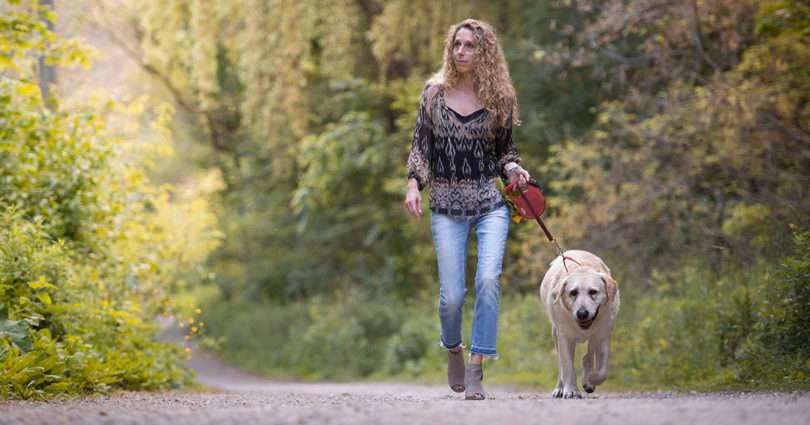Getting an Oncotype DCIS Score helped Janice Weintraub make a personal decision about treatment for her early-stage breast cancer. (Photograph by Kevin Van Paassen)
When Janice Weintraub was called in for more tests after her first-ever mammogram in 2015, she actually wasn’t too worried.
“I have no family history of breast cancer,” says Janice. “I just figured they’d do another test and I’d be given the all-clear.”
So when the then 50-year-old mother of two heard the words “breast cancer,” she was shocked. “I was told there was a suspicion of DCIS,” Janice says, “but that stage 1 breast cancer couldn’t be ruled out.”
DCIS – ductal carcinoma in situ – is early-stage, or stage 0, breast cancer. It’s a lesion in the breast that hasn’t invaded the surrounding tissue. While women with DCIS have a very low risk of dying of breast cancer, some women with DCIS are at a higher risk of developing invasive breast cancer in the future, notes Dr. Eileen Rakovitch, medical director of the Louise Temerty Breast Cancer Centre, head of Sunnybrook Odette Cancer Centre’s Breast Site Group, and the LC Campbell Breast Cancer Research Chair.
“We can’t accurately identify which women are indeed at high risk and will get breast cancer, and which women will not,” says Dr. Rakovitch. “So right now, we treat everyone.”
Breast screening programs mean that DCIS is being spotted in some women who may never otherwise realize they have the disease, have any symptoms or ever develop invasive, life-threatening breast cancer.
“On the other hand, the screening means that for some women, we are so lucky to find it and treat it at this stage before it becomes aggressive,” she says.
The challenge is in finding a balance between over-treatment and under-treatment. “We need to move away from a one-size-fits-all approach,” she adds. Currently, most women are treated with lumpectomy followed by radiation treatment.
Janice had two surgeries at another hospital to remove the suspicious tissue in her breasts. She then met with a radiation oncologist to plan for radiation treatment.
“To undergo radiation or not was a huge decision for me,” Janice says. “The concept of putting my system through the exposure and the side effects was very worrisome. Had it been a higher-stage cancer, I would have done anything to give me hope. But with DCIS, we didn’t know how fast or even if these atypical cells would become harmful.”
Breast pathologist Dr. Sharon Nofech-Mozes at Sunnybrook does her best to help personalize treatment. She examines a piece of every breast tissue that is removed from patients in order to better understand each individual case and help oncologists determine how best to treat each patient.
Under the microscope, she conducts a thorough examination that includes looking at the size of the tumour, how completely it was removed, and whether it has invaded tissue beyond the milk ducts.
After her investigation, oncologists may recommend additional surgery, radiation or the drug tamoxifen.
“I can look at two cases and they can look awfully similar,” Dr. Nofech-Mozes says. “But they might have other features on a genetic level that cannot be found in a regular tissue examination.”

Dr. Eileen Rakovitch’s research aims to balance the over-treatment of non-aggressive breast cancers and the under-treatment of cancer that could become aggressive. (Photograph by Kevin Van Paassen)
Now Dr. Nofech-Mozes and Dr. Rakovitch have something new in their toolbox to help them better understand who is at high risk of invasive cancer and would benefit from radiation, and whose risk is low.
Going beyond what can be viewed under a microscope, the Oncotype DX Breast DCIS Score test looks at 12 genes to see whether they are “turned on or off,” Dr. Nofech-Mozes says.
“For example, there are genes involved in cell proliferation – how fast a cell multiplies. The Oncotype DCIS Score looks for genes like these and then uses a formula to calculate a woman’s risk of recurrence,” she explains. “This is an additional layer of information that is being introduced.”
Janice did some digging online and found Sunnybrook’s research into the Oncotype DCIS Score. Her radiation oncologist encouraged her to reach out to Dr. Rakovitch, and Janice was accepted into the DUCHESS clinical trial at Sunnybrook, which measures the Oncotype DCIS Score in eligible women with DCIS. When her Oncotype DCIS Score came back low, she decided not to undergo radiation.
“The risk score helped inform the discussions with my partner,” she says. “He is a real numbers person and I needed something rational to hang the emotion on. And it really worked both ways. Had the score come back high, I couldn’t have stood in the face of science and rejected that radiation treatment. I wouldn’t have.”
That’s the wonderful thing about moving DCIS and breast cancer into the genome era, Dr. Rakovitch says.
“It’s individualized, personalized medicine. Instead of using broad estimates, a woman’s own DCIS is sampled and the expression of those genes is measured. We get her individual estimate of recurrence with or without radiation treatment.
“For example, let’s say her risk of recurrence is 9 per cent. With radiation, the risk might be reduced to 6 per cent. Many women and physicians say, ‘That’s such a small benefit; it’s not worth it.’ And so, they more confidently omit radiation treatment. For other women, the score identifies that they will benefit greatly from radiation and lessen their long-term risk.”
The DUCHESS trial is also examining whether the Oncotype DCIS Score affected a woman’s treatment plan or eased the decision-making process.
For Janice, who now undergoes yearly mammograms, that’s a yes. “I don’t know how I could have turned to my kids and said, ‘I’m not going to do the radiation even though the doctor says to [do it]’ if I didn’t have something concrete and rational to explain why. The Oncotype DCIS Score looked at my own genetics. That put me in a very different headspace for making decisions.”







